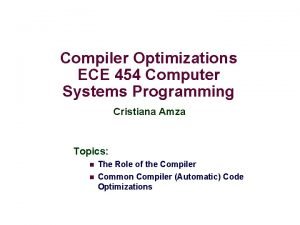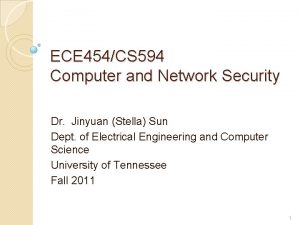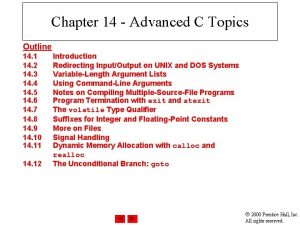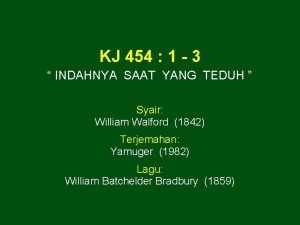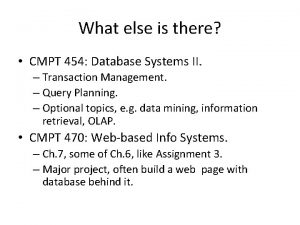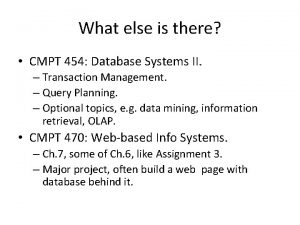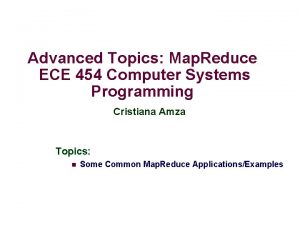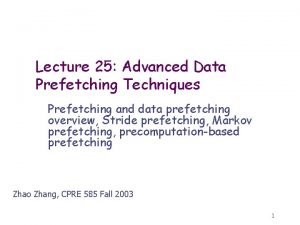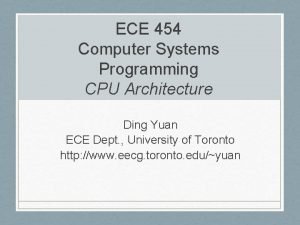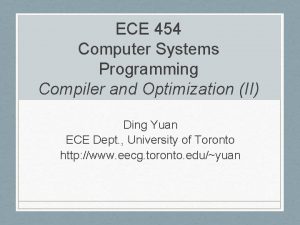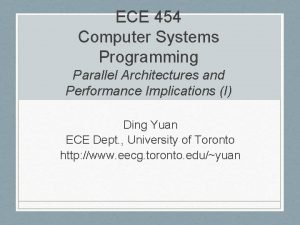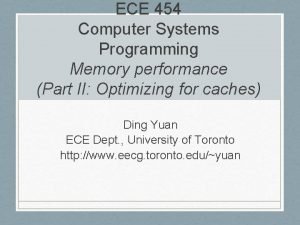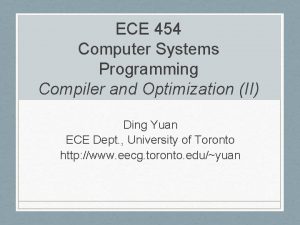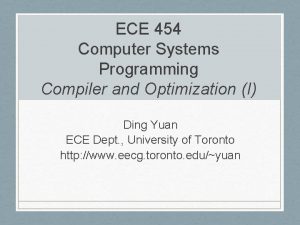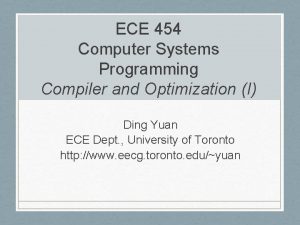Advanced Topics Prefetching ECE 454 Computer Systems Programming


















- Slides: 18

Advanced Topics: Prefetching ECE 454 Computer Systems Programming Cristiana Amza Topics: n UG Machine Architecture n Memory Hierarchy of Multi-Core Architecture Software and Hardware Prefetching n

Why Caches Work Locality: Programs tend to use data and instructions with addresses near or equal to those they have used recently Temporal locality: n Recently referenced items are likely to be referenced again in the near future Spatial locality: n – 2– block Items with nearby addresses tend to be referenced close together in time block

Example: Locality of Access sum = 0; for (i = 0; i < n; i++) sum += a[i]; return sum; Data: n n Temporal: sum referenced in each iteration Spatial: array a[] accessed in stride-1 pattern Instructions: n n Temporal: cycle through loop repeatedly Spatial: reference instructions in sequence Locality of code is a crucial skill for a programmer! – 3–

Prefetching Bring into cache elements expected to be accessed in the future (ahead of future access) Bringing in the cache a whole cache line instead of element by element already does this We will learn more general prefetching techniques In the context of the UG Memory Hierarchy – 4–

UG Core 2 Machine Architecture 32 KB, 8 -way data cache 32 KB, 8 -way inst cache Multi-chip Module Processor Chip P P L 1 Caches L 2 Cache 12 MB (2 X 6 MB), 16 -way Unified L 2 cache

Core 2 Architecture (2006): UG machines – 6–

UG Machines CPU Core Arch. Features 64 -bit instructions Deeply pipelined n n 14 stages Branches are predicted Superscalar n n – 7– Can issue multiple instructions at the same time Can issue instructions out-of-order

Core 2 Memory Hierarchy L 1/L 2 cache: 64 B blocks L 1 I-cache 32 KB C P U R e g L 1 D-cache Latency: 3 cycles 6 MB ~4 GB L 2 unified cache Main Memory 16 cycles 100 cycles 10 s of millions 8 -way 16 -way associative! Reminder: Conflict misses are not an issue nowadays Staying within on-chip cache capacity is key ~500 GB Disk

Get Memory System Details: lstopo Run lstopo on UG machine, gives: 4 GB RAM Machine (3829 MB) + Socket #0 L 2 #0 (6144 KB) 2 X 6 MB L 2 cache L 1 #0 (32 KB)+Core #0+PU #0 (phys=0) L 1 #1 (32 KB)+Core #1+PU #1 (phys=1) L 2 #1 (6144 KB) 32 KB L 1 cache per core L 1 #2 (32 KB) + Core #2 + PU #2 (phys=2) L 1 #3 (32 KB) + Core #3 + PU #3 (phys=3) – 9– 2 cores per L 2

Get More Cache Details: L 1 dcache ls /sys/devices/system/cpu 0/cache/index 0 n coherency_line_size: 64 n level: 1 // L 1 cache number_of_sets physical_line_partition shared_cpu_list shared_cpu_map size: type: data // data cache ways_of_associativity: 8 // 8 -way set associative n n n n – 10 – // 64 B cache lines

Get More Cache Details: L 2 cache ls /sys/devices/system/cpu 0/cache/index 2 n coherency_line_size: 64 n level: 2 // L 2 cache number_of_sets physical_line_partition shared_cpu_list shared_cpu_map size: 6144 K type: Unified // unified cache, means instructions and data ways_of_associativity: 24 // 24 -way set associative n n n n – 11 – // 64 B cache lines

Access Hardware Counters: perf The tool ‘perf’ allows you to access performance counters way easier than it used to be To measure L 1 cache load misses for program foo, run: perf stat -e L 1 -dcache-load-misses foo 7803 L 1 -dcache-load-misses # 0. 000 M/sec To see a list of all events you can measure: perf list Note: you can measure multiple events at once – 12 –

Prefetching ORIGINAL CODE: inst 1 inst 2 inst 3 inst 4 load X (misses cache) Cache miss latency inst 5 (must wait for load value) inst 6 CODE WITH PREFETCHING: inst 1 prefetch X inst 2 inst 3 Cache miss latency inst 4 load X (hits cache) inst 5 (load value is ready) inst 6 Basic idea: n Predicts which data will be needed soon (might be wrong) n Initiates an early request for that data (like a load-to-cache) If effective, can be used to tolerate latency to memory n

Prefetching is Difficult Prefetching is effective only if all of these are true: n There is spare memory bandwidth to begin with l Otherwise prefetches could make things worse n Prefetches are accurate l Only useful if you prefetch data you will soon use n Prefetches are timely l Ie. , prefetch the right data, but not early enough n Prefetched data doesn’t displace other in-use data l Eg: bad if PF replaces a cache block about to be used n Latency hidden by prefetches outweighs their cost l Cost of many useless prefetches could be significant Ineffective prefetching can hurt performance!

Hardware Prefetching A simple hardware prefetcher: n When one block is accessed prefetch the adjacent block n i. e. , behaves like blocks are twice as big A more complex hardware prefetcher: n n Can recognize a “stream”: addresses separated by a “stride” Eg 1: 0 x 1, 0 x 2, 0 x 3, 0 x 4, 0 x 5, 0 x 6. . . (stride = 0 x 1) Eg 2: 0 x 100, 0 x 300, 0 x 500, 0 x 700, 0 x 900… (stride = 0 x 200) Prefetch predicted future addresses l Eg. , current_address + stride*4 – 15 –

Core 2 Hardware Prefetching L 1/L 2 cache: 64 B blocks L 2 ->L 1 inst prefetching 6 MB ~4 GB L 2 unified cache Main Memory L 2 ->L 1 data prefetching Mem->L 2 data prefetching L 1 I-cache 32 KB CPU Reg L 1 D-cache Includes next-block prefetching and multiple streaming prefetchers They will only prefetch within a page boundary (details are kept vague/secret) ~500 GB (? ) Disk

Software Prefetching Hardware provides special prefetch instructions: n Eg. , intel’s prefetchnta instruction Compiler or programmer can insert them into the code: n Can PF patterns that hardware wouldn’t recognize (non-strided) void process_list(list_t *head){ list_t *p = head; while (p){ process(p); p = p->next; } } void process_list_PF(list_t *head){ list_t *p = head; list_t *q; while (p){ q = p->next; prefetch(q); process(p); p = q; } } Assumes process() is long enough to hide the prefetch latency

Memory Optimizations: Review Caches n Conflict Misses: l Less of a concern due to high-associativity (8 -way L 1, 16 -way L 2) n Cache Capacity: l Main concern: keep working set within on-chip cache capacity l Focus on either L 1 or L 2 depending on required working-set size Virtual Memory: n Page Misses: l Keep “big-picture” working set within main memory capacity n TLB Misses: may want to keep working set #pages < TLB #entries Prefetching: n n – 18 – Try to arrange data structures, access patterns to favor sequential/strided access Try compiler or manual-inserted prefetch instructions
 Ece 454
Ece 454 Cristiana amza
Cristiana amza Ece 454
Ece 454 Ece 454
Ece 454 Ece 454
Ece 454 Advanced topics in computer science
Advanced topics in computer science Data prefetching championship
Data prefetching championship Prefetching relevant priors
Prefetching relevant priors Advanced topics in software engineering
Advanced topics in software engineering Angular guard naming convention
Angular guard naming convention Angular advanced topics
Angular advanced topics Advanced c topics
Advanced c topics Advanced topics in web development
Advanced topics in web development Android advanced topics
Android advanced topics Vdv454
Vdv454 Kj 454
Kj 454 Ars 46-454
Ars 46-454 Cmpt 454
Cmpt 454 Cmpt 454
Cmpt 454

